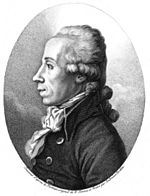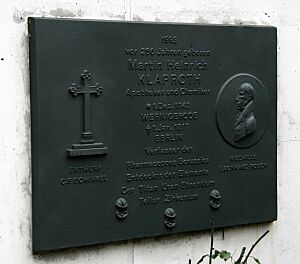Martin Heinrich Klaproth facts for kids
Quick facts for kids
Martin Klaproth
|
|
|---|---|
 |
|
| Born | 1 December 1743 Wernigerode, Kingdom of Prussia
|
| Died | 1 January 1817 (aged 73) Berlin, Kingdom of Prussia
|
| Nationality | German |
| Citizenship | Wernigerode |
| Known for | Discovery of uranium, zirconium, and other elements |
| Scientific career | |
| Fields | Chemistry |
Martin Heinrich Klaproth (born December 1, 1743 – died January 1, 1817) was an important German chemist. He spent most of his life working as an apothecary, which is like a pharmacist who also prepares medicines. Later in his life, he became a university professor.
Klaproth's apothecary shop in Berlin grew to be the second largest. It was also a very active place for chemical research in Europe. He was a key figure in understanding what minerals are made of. He also helped to identify many different elements.
Klaproth is famous for discovering uranium and zirconium in 1789. He also helped discover or confirm other elements. These include titanium (1792), strontium (1793), cerium (1803), and chromium (1797). He also confirmed the discovery of tellurium (1798) and beryllium (1798).
He was a member and director of the Berlin Academy of Sciences. He was also recognized by important groups like the Royal Society in London.
Contents
Becoming a Chemist
Martin Klaproth was born in Wernigerode, Germany. His father was a tailor. Martin went to a Latin school for four years.
When he was 16, in 1759, he started training to be an apothecary. This training took many years. He worked in pharmacies in different cities like Quedlinburg, Hanover, Berlin, and Danzig.
In 1771, Klaproth came back to Berlin. He worked for Valentin Rose the Elder, managing his business. After Rose passed away, Klaproth took exams to become the senior manager.
In 1780, Klaproth got married and was able to buy his own apothecary shop. He named it "Apotheke zum Baren." Between 1782 and 1800, he wrote 84 scientific papers. These papers were based on his research done right in his shop's laboratory. His shop became the most active place for chemical studies in Europe at that time.
Teaching and Research
From 1782, Klaproth helped examine new pharmacists. In 1787, he became a chemistry lecturer for the Prussian Royal Artillery.
In 1788, he joined the Berlin Academy of Sciences. By 1800, he became the paid director of the Academy. He sold his apothecary shop and moved to the Academy. He convinced them to build a new laboratory. In 1802, he moved all his equipment from his old shop to the new lab.
When the University of Berlin was started in 1810, Klaproth was chosen to be the professor of chemistry. He taught there until he passed away in Berlin on January 1, 1817.
Klaproth's Discoveries
Klaproth was a very careful and exact scientist. He greatly improved how chemists analyze chemicals and minerals. He was one of the first scientists outside of France to support Lavoisier's ideas. Lavoisier's ideas were about using exact measurements in chemistry.
Discovering Uranium
Klaproth was the first to discover uranium. He first found it in a mineral called torbernite. But he did most of his research on it using a mineral called pitchblende. On September 24, 1789, he announced his discovery to the Royal Prussian Academy of Sciences in Berlin. Uranium is now well-known for its use in nuclear energy.
Finding Zirconium
He also discovered zirconium in 1789. He separated it as its oxide, called zirconia (ZrO2). Klaproth studied a bright-colored mineral from Ceylon called "hyacinth." He named the new element zirconium. This name came from the Persian word "zargun," which means "gold-colored." Klaproth showed that uranium and zirconium were new, distinct elements. However, he did not get them in their pure metal form.
Cerium and Titanium
Klaproth also independently discovered cerium in 1803. This happened around the same time as two other scientists, Jöns Jacob Berzelius and Wilhelm Hisinger. Cerium is a rare earth element.
The element titanium was first identified by William Gregor in 1791. He found it in an ore called ilmenite. Klaproth later confirmed the presence of an unknown element in a different ore called rutile in 1795. Klaproth suggested the name "titanium." Later, it was found that Gregor's "menachanite" and Klaproth's "titanium" were the same element. Klaproth's name was then used.
Other Elements
Klaproth helped clarify the makeup of many substances. These included compounds of elements that had been newly recognized. These elements were tellurium, strontium, and chromium.
Chromium was discovered in 1797 by Louis Nicolas Vauquelin. Klaproth also independently discovered it in 1798. He confirmed that chromium was a unique element.
The element tellurium was first suggested in 1783 by Franz-Joseph Mueller von Reichenstein. Mueller sent some of his mineral to Klaproth in 1796. Klaproth isolated the new substance and confirmed it was a new element in 1798. He gave credit to Mueller for the discovery. He suggested naming the heavy metal "tellus," which is Latin for 'earth'.
Klaproth was also involved in studying strontium. In 1790, other scientists found that the mineral strontianite was different from barium-based minerals. Klaproth, along with other scientists, studied strontianite. He published his findings on separating strontium from barium in 1793. He also wrote about preparing strontium oxide in 1794. The pure element was first isolated in 1808 by Humphry Davy.
In 1798, Louis Nicolas Vauquelin reported a new element in emerald and beryl. He suggested naming it "glucine." Klaproth confirmed this new element. He suggested the name "beryllia." The element was finally isolated in 1828. It is now known as beryllium.
Legacy
Klaproth wrote many scientific papers, over 200 in total. He collected them into several books. He also published a chemistry dictionary.
He became a foreign member of the Royal Society of London in 1795. He also joined the Royal Swedish Academy of Sciences in 1804. He was also a member of the Institut de France.
A crater on the Moon is named Klaproth in his honor. In 1823, a botanist named a group of flowering plants, Klaprothia, after him.
His son, Julius Klaproth, became a famous scholar of Asian languages and cultures.
Images for kids
See also
 In Spanish: Martin Heinrich Klaproth para niños
In Spanish: Martin Heinrich Klaproth para niños



